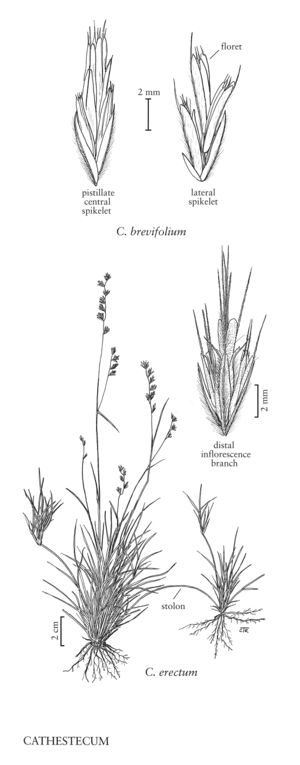Cathestecum brevifolium
Plants perennial; polygamous or dioecious; cespitose, forming dense, small clumps, stoloniferous, stolons thin, internodes to 10 (12) cm, straight or only slightly arching. Culms 5-15 cm, erect or geniculate. Leaves primarily basal; lower sheaths densely villous basally, mostly glabrous or sparsely pilose distally, throats densely ciliate; blades 1-5 cm long, 1-2 mm wide, stiff, flat to involute, abaxial surfaces glabrous, adaxial surfaces scabrous and pilose, margins scabrous. Panicles with 3-10 branches; branches divergent, dimorphic, bearing staminate or bisexual spikelets, spikelets usually reddish or purple. Staminate branches: all spikelets similar; lower glumes to 1 mm, often reduced to a scale, 0-1-veined; upper glumes 1/2 - 2/3 as long as the spikelets, narrowly trullate to lanceolate, usually glabrous, veins sometimes sparsely pilose, glumes of the lateral spikelets about 2.5 mm, acute or acuminate, those of the central spikelets about 3 mm, minutely lobed and mucronate; lowest lemmas to 3 mm, sparsely pilose, with short lobes, mucronate between the lobes; distal lemmas to 2.5 mm, similar to the lowest lemmas but with deeper lobes; anthers 0.7-2 mm. Bisexual branches: lateral spikelets poorly developed, lower glumes to 1 mm, upper glumes to 2.5 mm, veins pilose, florets greatly reduced, sometimes just a cluster of awns, sterile (rarely staminate); central spikelets with glumes similar to those of the lateral spikelets; lowest florets pistillate, lemmas about 3 mm, scabrous, lobed, lobes about 1/4 as long as the lemmas, awned from the sinuses, awns slightly exceeding the lobes; distal florets staminate or sterile, about 2.5 mm, deeply lobed, awned from the sinuses, awns exceeding the lobes by 1-3 mm. 2n = 20, 40, 60, and 80.
Discussion
The range of Cathestecum brevifolium extends from Ragged Top Mountain, Arizona, to El Salvador and Honduras. The Arizonan plants were originally identified as C. erectum but, like many Mexican popu¬lations of C. brevifolium, they have 2n = 60 and are dimorphic, consisting of relatively long-awned pistillate plants and more shortly-awned staminate plants (J.R. Reeder, pers. comm.).
Selected References
None.
Lower Taxa
"decumbent" is not a number.
